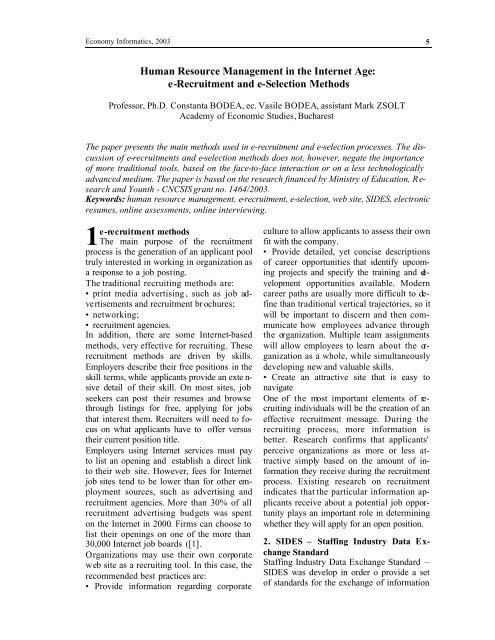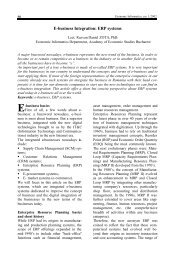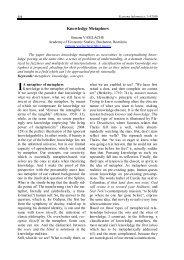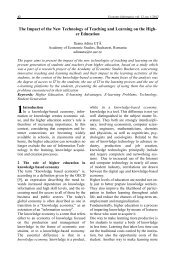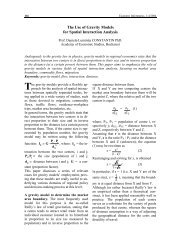Human Resource Management in the Internet Age: e-Recruitment ...
Human Resource Management in the Internet Age: e-Recruitment ...
Human Resource Management in the Internet Age: e-Recruitment ...
You also want an ePaper? Increase the reach of your titles
YUMPU automatically turns print PDFs into web optimized ePapers that Google loves.
Economy Informatics, 2003<br />
<strong>Human</strong> <strong>Resource</strong> <strong>Management</strong> <strong>in</strong> <strong>the</strong> <strong>Internet</strong> <strong>Age</strong>:<br />
e-<strong>Recruitment</strong> and e-Selection Methods<br />
Professor, Ph.D. Constanta BODEA, ec. Vasile BODEA, assistant Mark ZSOLT<br />
Academy of Economic Studies, Bucharest<br />
The paper presents <strong>the</strong> ma<strong>in</strong> methods used <strong>in</strong> e-recruitment and e-selection processes. The discussion<br />
of e-recruitments and e-selection methods does not, however, negate <strong>the</strong> importance<br />
of more traditional tools, based on <strong>the</strong> face-to-face <strong>in</strong>teraction or on a less technologically<br />
advanced medium. The paper is based on <strong>the</strong> research f<strong>in</strong>anced by M<strong>in</strong>istry of Education, R esearch<br />
and Younth - CNCSIS grant no. 1464/2003.<br />
Keywords: human resource management, e-recruitment, e-selection, web site, SIDES, electronic<br />
resumes, onl<strong>in</strong>e assessments, onl<strong>in</strong>e <strong>in</strong>terview<strong>in</strong>g.<br />
1<br />
e-recruitment methods<br />
The ma<strong>in</strong> purpose of <strong>the</strong> recruitment<br />
process is <strong>the</strong> generation of an applicant pool<br />
truly <strong>in</strong>terested <strong>in</strong> work<strong>in</strong>g <strong>in</strong> organization as<br />
a response to a job post<strong>in</strong>g.<br />
The traditional recruit<strong>in</strong>g methods are:<br />
• pr<strong>in</strong>t media advertis<strong>in</strong>g , such as job advertisements<br />
and recruitment br ochures;<br />
• network<strong>in</strong>g;<br />
• recruitment agencies.<br />
In addition, <strong>the</strong>re are some <strong>Internet</strong>-based<br />
methods, very effective for recruit<strong>in</strong>g. These<br />
recruitment methods are driven by skills.<br />
Employers describe <strong>the</strong>ir free positions <strong>in</strong> <strong>the</strong><br />
skill terms, while applicants provide an exte nsive<br />
detail of <strong>the</strong>ir skill. On most sites, job<br />
seekers can post <strong>the</strong>ir resumes and browse<br />
through list<strong>in</strong>gs for free, apply<strong>in</strong>g for jobs<br />
that <strong>in</strong>terest <strong>the</strong>m. Recruiters will need to focus<br />
on what applicants have to offer versus<br />
<strong>the</strong>ir current position title.<br />
Employers us<strong>in</strong>g <strong>Internet</strong> services must pay<br />
to list an open<strong>in</strong>g and establish a direct l<strong>in</strong>k<br />
to <strong>the</strong>ir web site. However, fees for <strong>Internet</strong><br />
job sites tend to be lower than for o<strong>the</strong>r employment<br />
sources, such as advertis<strong>in</strong>g and<br />
recruitment agencies. More than 30% of all<br />
recruitment advertis<strong>in</strong>g budgets was spent<br />
on <strong>the</strong> <strong>Internet</strong> <strong>in</strong> 2000. Firms can choose to<br />
list <strong>the</strong>ir open<strong>in</strong>gs on one of <strong>the</strong> more than<br />
30,000 <strong>Internet</strong> job boards ([1].<br />
Organizations may use <strong>the</strong>ir own corporate<br />
web site as a recruit<strong>in</strong>g tool. In this case, <strong>the</strong><br />
recommended best practices are:<br />
• Provide <strong>in</strong>formation regard<strong>in</strong>g corporate<br />
culture to allow applicants to assess <strong>the</strong>ir own<br />
fit with <strong>the</strong> company.<br />
• Provide detailed, yet concise descriptions<br />
of career opportunities that identify upcom<strong>in</strong>g<br />
projects and specify <strong>the</strong> tra<strong>in</strong><strong>in</strong>g and development<br />
opportunities available. Modern<br />
career paths are usually more difficult to def<strong>in</strong>e<br />
than traditional vertical trajectories, so it<br />
will be important to discern and <strong>the</strong>n communicate<br />
how employees advance through<br />
<strong>the</strong> organization. Multiple team assignments<br />
will allow employees to learn about <strong>the</strong> organization<br />
as a whole, while simultaneously<br />
develop<strong>in</strong>g new and valuable skills.<br />
• Create an attractive site that is easy to<br />
navigate<br />
One of <strong>the</strong> most important elements of recruit<strong>in</strong>g<br />
<strong>in</strong>dividuals will be <strong>the</strong> creation of an<br />
effective recruitment message. Dur<strong>in</strong>g <strong>the</strong><br />
recruit<strong>in</strong>g process, more <strong>in</strong>formation is<br />
better. Research confirms that applicants'<br />
perceive organizations as more or less attractive<br />
simply based on <strong>the</strong> amount of <strong>in</strong>formation<br />
<strong>the</strong>y receive dur<strong>in</strong>g <strong>the</strong> recruitment<br />
process. Exist<strong>in</strong>g research on recruitment<br />
<strong>in</strong>dicates that <strong>the</strong> particular <strong>in</strong>formation applicants<br />
receive about a potential job opportunity<br />
plays an important role <strong>in</strong> determ<strong>in</strong><strong>in</strong>g<br />
whe<strong>the</strong>r <strong>the</strong>y will apply for an open position.<br />
2. SIDES – Staff<strong>in</strong>g Industry Data Exchange<br />
Standard<br />
Staff<strong>in</strong>g Industry Data Exchange Standard –<br />
SIDES was develop <strong>in</strong> order o provide a set<br />
of standards for <strong>the</strong> exchange of <strong>in</strong>formation<br />
5
6<br />
between staff<strong>in</strong>g customers, sta ff<strong>in</strong>g suppliers<br />
and <strong>in</strong>termediaries ([3]). SIDES consist of<br />
a suite of XML-based specifications designed<br />
to support a full range of staff<strong>in</strong>g processes.<br />
These standards will enable all participants <strong>in</strong><br />
<strong>the</strong> staff<strong>in</strong>g supply cha<strong>in</strong> (staff<strong>in</strong>g companies,<br />
hir<strong>in</strong>g managers etc.) to exchange <strong>in</strong>formation<br />
about job requisitions, candidates, assignments,<br />
time sheets etc. electronically,<br />
and dramatically reduce <strong>the</strong> cost and cycle<br />
times of data entry and data errors. The standard<br />
is <strong>in</strong>itiated by HR-XML<br />
(www.hr-xml.org), an <strong>in</strong>dependent, nonprofit<br />
consortium dedicated to enabl<strong>in</strong>g ecommerce<br />
and <strong>in</strong>ter-company exchange of<br />
human resources data worldwide. The work<br />
of <strong>the</strong> Consortium centers on <strong>the</strong> develop-<br />
With ProSource, corporations can automate<br />
<strong>the</strong> staff<strong>in</strong>g supply cha<strong>in</strong> from sourc<strong>in</strong>g to<br />
payment, speed candidate sourc<strong>in</strong>g and engagement,<br />
consolidate bill<strong>in</strong>g, streaml<strong>in</strong>e<br />
vendor activity and receive comprehensive<br />
bus<strong>in</strong>ess <strong>in</strong>telligence (see figure 2). In addition<br />
value added services such as cost effective<br />
payroll and compliance ma nagement of<br />
contract workforce regulations (eWork Services)<br />
complete <strong>the</strong> offer<strong>in</strong>g. ProSource supports<br />
multi-language and currency, provides<br />
a web services based <strong>in</strong>tegration framework<br />
for ERP, HRMS and eProcurement and is<br />
HR-XML certified ([4]).<br />
4. e -Selection methods<br />
Usually, it is difficult to decide where recruit<strong>in</strong>g<br />
ends and selection beg<strong>in</strong>s. The ma<strong>in</strong><br />
Fig. 1. eWork solution<br />
Economy Informatics, 2003<br />
ment and promotion of standardized XML<br />
vocabularies for HR. HR-XML’s current efforts<br />
are focused on standards for staff<strong>in</strong>g<br />
and recruit<strong>in</strong>g, compensation and benefits,<br />
tra<strong>in</strong><strong>in</strong>g and work force management. HR-<br />
XML is represented by its membership <strong>in</strong> 22<br />
countries.<br />
3. eWork – <strong>in</strong>tegrated and HR-XML ce rtified<br />
solution for flexible workforce<br />
management<br />
eWork is based on an end-to-end procurement<br />
platform for sourc<strong>in</strong>g, hir<strong>in</strong>g, mana g<strong>in</strong>g,<br />
<strong>in</strong>voic<strong>in</strong>g, payment and pay roll<strong>in</strong>g <strong>the</strong><br />
enterprise-wide contract workforce, named<br />
ProSource (see figure 1).<br />
purpose of <strong>the</strong> selection process is to dist<strong>in</strong>guish<br />
<strong>in</strong>dividuals on <strong>the</strong> basis of important<br />
characteristics. In a chang<strong>in</strong>g environment,<br />
<strong>the</strong> speed of <strong>the</strong> selection process becomes<br />
important. Selection systems that process applicants<br />
<strong>in</strong> 2-3 months fall <strong>in</strong> solv<strong>in</strong>g orga nizational<br />
needs. A cycle of 2-3 days from applicant<br />
identification to employment offer<br />
will be more suitable<br />
There are many formal selection tools available<br />
to measure applicants on <strong>the</strong> characteristics:<br />
• work samples<br />
• structured <strong>in</strong>terviews<br />
• personality <strong>in</strong>ventories<br />
• situational judgment tests<br />
• cognitive ability tests
Economy Informatics, 2003<br />
Fig. 2. ProSource cha<strong>in</strong><br />
e-Selection is a paperless process where<br />
electronic documents and <strong>in</strong>formation can<br />
be quickly dissem<strong>in</strong>ated nationwide or<br />
worldwide. The most important methods for<br />
e-recruitment are:<br />
• electronic resumes<br />
• onl<strong>in</strong>e assessments<br />
• onl<strong>in</strong>e <strong>in</strong>terview<strong>in</strong>g<br />
• onl<strong>in</strong>e assessment centers<br />
Electronic resumes<br />
Applicants submit <strong>the</strong>ir resume us<strong>in</strong>g e i<strong>the</strong>r email<br />
or <strong>the</strong> organization's website. With ele ctronic<br />
submission, applicants can send <strong>the</strong>ir<br />
resumes to thousands of organizations.<br />
More than 2.5 million resumes were already<br />
onl<strong>in</strong>e <strong>in</strong> January 2001.<br />
For experienced candidates, resumes repr esent<br />
an efficient way to stress on cognitive<br />
ability, job knowledge, and capacity to work.<br />
Resumes that outl<strong>in</strong>e position accomplis hments<br />
with quality <strong>in</strong>dicators represent an <strong>in</strong>dividual's<br />
work portfolio. S<strong>in</strong>ce past pe rformance<br />
is one of <strong>the</strong> best predictors of future<br />
performance, resume <strong>in</strong>formation that<br />
outl<strong>in</strong>es past performance will serve as a<br />
proxy measure of job knowledge and an applicant's<br />
ability to perform similar respons ibilities<br />
<strong>in</strong> a new organization.<br />
Resumes will also provide education and<br />
grade po<strong>in</strong>t average (GPA) <strong>in</strong>formation. GPA<br />
represents a measure of cognitive ability, be<strong>in</strong>g<br />
a compound <strong>in</strong>dex that captures cognitive<br />
ability and motivation. Many large organizations,<br />
such as Microsoft, request GPA <strong>in</strong>formation<br />
from applicants.<br />
Onl<strong>in</strong>e assessment<br />
Previously paper-based <strong>in</strong>struments become<br />
web-viewable. Interactive forms allow applicants<br />
to access a web site, complete and summit<br />
<strong>the</strong>ir responses. Applicant’s responses are<br />
scored automatically and applicant profile is<br />
generated immediately. Onl<strong>in</strong>e test<strong>in</strong>g allows a<br />
company to offer applicants an immediate<br />
feedback concern<strong>in</strong>g <strong>the</strong>ir potential fit with <strong>the</strong><br />
organization.<br />
Onl<strong>in</strong>e <strong>in</strong>terview<strong>in</strong>g<br />
Most companies evaluate candidates on <strong>in</strong>terviews<br />
based. Interviews can be designed to<br />
measure almost any applicant characteristic.<br />
While a structured <strong>in</strong>terview measures cognitive<br />
ability, a structure <strong>in</strong>terview measures <strong>in</strong>terpersonal<br />
skills.<br />
The technologies used to conducts applicants<br />
<strong>in</strong>terviews onl<strong>in</strong>e are video-conferenc<strong>in</strong>g technology<br />
and web cams, which allow for video<br />
and audio stream<strong>in</strong>g between geographically<br />
remote locations ([2]).<br />
5. Conclusions<br />
The discussion of e-recruitments and e-selection<br />
methods does not, however, negate<br />
<strong>the</strong> importance of more traditional tools,<br />
based on <strong>the</strong> face-to-face <strong>in</strong>teraction or on a<br />
less advanced technological medium. In<br />
many cases, traditional approaches may not<br />
be feasible, requir<strong>in</strong>g <strong>the</strong> use of <strong>the</strong> new techniques.<br />
References<br />
1. Heneman R., Greenberger D. (eds.)- <strong>Human</strong><br />
<strong>Resource</strong> <strong>Management</strong> <strong>in</strong> Virtual Organization<br />
, Information <strong>Age</strong> Publish<strong>in</strong>g Inc.,<br />
2002.<br />
2. Bodea C. – Sisteme de videoconfer<strong>in</strong>te în<br />
procesul de <strong>in</strong>struire, Timisoara, 2002.<br />
3. www.hr-xml. org<br />
4. www.ework.com<br />
7


